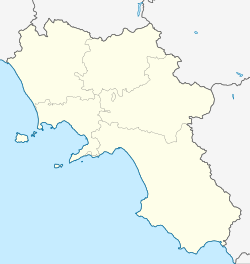world.wikisort.org - Italy
Teora is a small town and comune in the province of Avellino, in the Campania region of southern Italy.
This article may be expanded with text translated from the corresponding article in Italian. (January 2022) Click [show] for important translation instructions.
|
Teora | |
|---|---|
Comune | |
| Comune di Teora | |
 | |
Location of Teora  | |
 Teora Location of Teora in Italy  Teora Teora (Campania) | |
| Coordinates: 40°51′08″N 15°15′14″E | |
| Country | Italy |
| Region | Campania |
| Province | Avellino (AV) |
| Government | |
| • Mayor | Stefano Farina |
| Area | |
| • Total | 23.21 km2 (8.96 sq mi) |
| Elevation | 660 m (2,170 ft) |
| Population (31 December 2017)[2] | |
| • Total | 1,494 |
| • Density | 64/km2 (170/sq mi) |
| Demonym | Teoresi |
| Time zone | UTC+1 (CET) |
| • Summer (DST) | UTC+2 (CEST) |
| Postal code | 83056 |
| Dialing code | 0827 |
| Patron saint | Saint Nicolas |
| Saint day | 6 December |
| Website | Official website |
Geography
Teora is bordered by the towns of Caposele, Conza della Campania, Lioni and Morra De Sanctis.
History
The origin of the village was recorded by the Greek historian Dionysius of Halicarnassus (1st century BC) and by the Roman historian Marcus Terentius Varro.
It was also reported that the tribuno della plebe Milo died there during the civil war between Julius Caesar and Pompey in the Roman era. In a privilege of 1200, granted by Pope Innocent III to Pantaleone, archbishop of Conza, Teora is referred to using the name Tugurium Biarium for the first time.
In the late Middle Ages and modern era it was a fief hold by several local noble families.
Three earthquakes have occurred in Teora, in 1694, 1732, and 1980 respectively; the last earthquake destroyed much of the village's historical and cultural identity.
Main sights
This section is written like a travel guide rather than an encyclopedic description of the subject. (January 2022) |
- Fountain of Monte, also called the fountain of the dead men, has its origins in the 12th century, when the Church of Conza was designated by pope Callixtus II as a necropolis.
- Church of Saint Nicholas
- Corona flour mill
- Fountain (public washhouse) of Piano
- Stone of the civil weddings
Culture
Squaqqualacchiun' is a typical masque related to the day of Saint Anthony, January 17, on which the first day of the carnival is held. This event is featured in the Museum of Popular Traditions at Caserta.[citation needed]
References
- "Superficie di Comuni Province e Regioni italiane al 9 ottobre 2011". Italian National Institute of Statistics. Retrieved 16 March 2019.
- "Popolazione Residente al 1° Gennaio 2018". Italian National Institute of Statistics. Retrieved 16 March 2019.
Sources
- Donatello, Filomena (1998). Teora nei documenti e nei monumenti. Avellino: IRB Redi Editore.
External links
На других языках
[de] Teora
Teora ist eine italienische Gemeinde mit 1459 Einwohnern (Stand 31. Dezember 2019) in der Provinz Avellino in der Region Kampanien. Der Ort ist Teil der Comunità Montana Alta Irpinia.- [en] Teora
[es] Teora
Teora es uno de los 119 municipios o comunas ("comune" en italiano) de la provincia de Avellino, en la región de Campania.[ru] Теора
Теора (итал. Teora) — коммуна в Италии, располагается в регионе Кампания, в провинции Авеллино.Другой контент может иметь иную лицензию. Перед использованием материалов сайта WikiSort.org внимательно изучите правила лицензирования конкретных элементов наполнения сайта.
WikiSort.org - проект по пересортировке и дополнению контента Википедии
